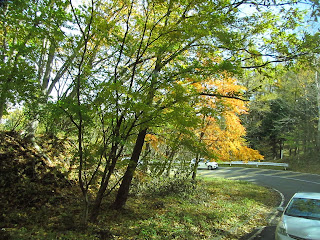We had booked two day trips - and this was the first one, to Nikko. I always like day trips - they tend to be very good value for money as the tour packs in a number of places, gives us a typically decent lunch and there’s not too much walking. Best of all, absolutely no hassle about working out the schedule, transportation etc. All we need to do is get ourselves to the pick-up point and since we chose tours where we get picked up around Shinjuku, we ourselves don’t need to spend too much time travelling to the pick up point.
Anyway, the day dawned bright and sunny, what we thought was a good sign for the day ahead. So we got ourselves to the pick up point, boarded our bus etc. Turned out that we had two guides - the main one was supposed to be this sweet, soft spoken Japanese lady whose English wasn’t the greatest. It was the Assistant Tour Guide, an enthusiastic Filipino guy who did most of the talking and most of the “tour guide” work of getting the group together, giving directions etc.
We were supposed to be going up the Iron Road, Irohazaka Road, and visiting the scenic spots on top. Now this was not an easy tour to find because in the autumn leaf period, the road is jam packed and so tour bus access is limited. As a result, many tours avoid going here altogether. So we were actually quite lucky to find this, perhaps because the day started off with the Irohazaka and ended off with Nikko whereas most other tours do it the other way around.
 |
| Round the bend - going up the Irohazaka Road |
Our first stop at the top of the hill was Senjogahara, which is supposed to be the “fighting field” where two Gods fought their battle. Because of the fury of the battle, the trees were all destroyed, leaving a flat grassland behind. It is supposed to be a most scenic place, with lots of wildlife. But quite clearly, they were not happy about the snow as there were none in sight And neither were we happy! Given the bright start to the day, we were not quite prepared for snowy temperatures, now for the brisk winds which sent snowflakes swirling around us. Fortunately I had my warm down jacket but others were not so well-prepared.... one person just had a light jumper and another had only a short sleeved shirt with a vest over it.
 |
| Kegon waterfall |
Our last scenic stop before descending the hill was the Kegon waterfall. This was 97m high and is supposed to be one of the most beautiful waterfalls in Japan. Indeed it was quite magnificent to see the water plunging down and it was even a little exhilarating to be out there amidst the chilly conditions.
After the waterfall, we went on to see the Tokugawa shrine, one of the marvels of Nikko. Built by his son and grandson, it is where Ieyesu Tokugawa, the famous shogun of Japan, is buried. The Tokugawa shogunate which he founded would continue to rule Japan for over two centuries, from 1603-1867.
 |
| Entrance to the shrine |
The shrine itself is magnificent, with beautifully carved, ornate carvings. The artist certainly took his inspiration from the animal kingdom because he has carved animals every where - the three monkeys, a sleeping cat, and imaginary elephants (carved by someone who thinks the elephant is all about the trunk and tusks) and the crane and the lion on the tomb of the Shogun. Some parts of the shrine are under renovation, so we probably missed some of the beautiful inner halls, but I was glad that we were able to see the majestic Yomeimon Gate and hear the echos and vibrato of the acoustics in the "dragon Chamber".
Fortunately, the weather here at the shrine was really very pleasant - a lovely autumn day. We wandered through the buildings of the shrine, and climbed all the way up to the tomb. There was a little boy, Kenzo, on our tour, and he was happily (and not particularly accurately) counting the steps all the way to the tomb and also charming us with his childish prattle.
Went back to Tokyo, at the end of a tiring day. I certainly didn’t expect to experience summer in the morning, winter at noon, and autumn in the afternoon.



No comments:
Post a Comment